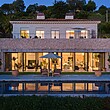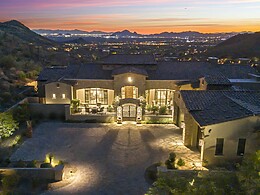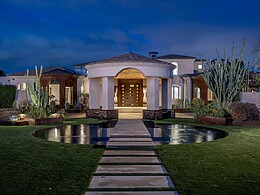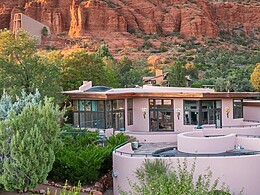
Reclaimed furnishings are used for this guest bedroom in Santa Barbara. Photo courtesy Tanya Shively
By Tanya Shively, ASID, LEED AP (with David M. Brown)
This Earth Day, April 22, Earth will never forget.
With the COVID-19 pandemic changing world history, perhaps we can now best appreciate our connectedness to each other as well as our limited planetary resources. Isolated, we can each reaffirm the concept of Spaceship Earth, popularized by leaders such as George Orwell, Adlai Stevenson, Barbara Ward and Buckminster Fuller. It’s a relatively recent metaphor, but the message is as old as Genesis: We are the keepers of the bounty we have been given.
Earth Day has been the core of my personal and work philosophy: the stewardship of our planet. This is our responsibility, the “dominion” referred to in that first chapter of the Bible; we can either ravage our resources or we can be thoughtful and respectful of the right of future generations to enjoy what we enjoy.
The natural beauty we are surrounded by can never be recovered. How can you replace the bald eagle or the sequoia or our splendid desert spring wildflowers? I grew up near Jackson Hole, Wyoming, near the Grand Tetons and Yellowstone; those environments continue to inspire me because they exemplify what Earth Day means to me every day.
One of my guiding quotes has always been that of the great naturalist John Muir, founder of the Sierra Club: “Not blind opposition to progress, but opposition to blind progress . . .
Throughout my career, I have used reclaimed materials in my interior design projects whenever I can and with the approval of my clients. We are not using new resources but reusing materials that have already been processed and made into a “new” product. Reusing saves not only the physical resource but also the energy involved in the process of transforming the raw material into an interior floor, a courtyard, a countertop, a ceiling or a roof.
In addition, reclaimed materials already have a gorgeous patina and character that people so often want and will spend extra time, energy and effort to add to new materials through distressing. These bricks and beams, pavers and ceramics, have a history that immediately speaks to the perceiver, and they give a sense of place to a home. They ask questions and have a mystery new items don’t.

The Reclaimed Parfeuille process begins with stripping the roof. Photo courtesy Craftsman Court Ceramics
We have worked with a number of eco-concerned Valley-based companies on our projects. From Craftsman Court Ceramics in downtown Scottsdale, we have sourced Antique French Parfeuille terracotta pavers. Sourced from Haussmann Stone, they are reclaimed from old French buildings and are repurposed as flooring. Each paver is at least 150 years old, and some have bird and paw prints from the site where they were created.
Another product we have used from Craftsman Court, Dakota Brick, is from Sonoma Tilemakers, whose owner discovered roof tiles of abandoned buildings in South America. They were being buried for disposal; now they’re living again in spaces throughout the world.

The Reclaimed Parfeuille tiles are reinstalled as flooring. Photo courtesy Craftsman Court Ceramics
“Tanya has been a long-standing client of Craftsman Court Ceramics for many years,” says Lindsey Clum, executive director of sales and outside design consultant for the tile and design studio founded in 1994 in downtown Scottsdale. “She is one of the few designers whose purpose is twofold: to create an inviting and beautiful space for her client while using sustainable and earth-friendly products that help, not hurt our community.”
Other Examples
We have also worked with Telluride Natural Stone in Phoenix to provide reclaimed beams and similar wood products, which have been repurposed as fireplace mantels and flooring.
Old doors and gates, for instance, can be repurposed as coffee tables and headboards. They provide instant interest, an effect that would be so expensive to try to recreate from new materials.

Multiple antiques are used in the living room of this Santa Barbara California home. Photo courtesy Tanya Shively
Reclaimed stonework repurposes for fireplace surrounds and mantels. These can be trickier to use because of restrictions on size, but often they can be modified to fit a new fireplace with a minimum of changes. And outside, old stone fountains, water troughs and sinks perform beautifully. Once again, they inspire questions from your visitors: Where was this originally? How old is it? Where can I get something like it for my side courtyard by the pergola?
Slightly different, but a similar concept, is reusing furnishings. Antique or vintage pieces can be refinished and refurbished to create great additions to any room. You don’t need to be designing in a traditional style to use antiques, and your whole home needn’t be all Mid-Century Modern to add a piece of Danish Modern somewhere.
Sometimes reclaimed assets are more costly than newly manufactured versions. The labor to rescue the material and keep it in usable condition is far greater than just razing an entire structure without regarding individual components. And, for flooring, often there needs to be some milling or finishing to make it usable. For instance, bricks may need some or all of the original grout removed.
But, in other cases, repurposing old architectural structural pieces can be more cost effective because it’s often easier to rescue these rather than “antiquing” newly manufactured pieces.
I have frequently used repurposed doors as furniture or a wooden wagon wheel hub as a lamp support. Many times I refinish or recover existing furniture to reuse rather than trash it. Reclaimed wood floors –– hickory from an old Midwest barn or old oak planks from an early-20th-century school –– are incredibly beautiful and can work in a Contemporary-style home.
And sometimes almost all materials from an old building are used to build a new one. The effect is gorgeous.
As part of my mission to be responsible to the planet and create “WELL Designed” homes that are eco-conscious, healthy and very livable, I recently founded The Furniture Angel, a nonprofit that helps to keep high-end furniture out of landfills by offering a path to donation and a tax deduction for the responsible homeowner. This effort focuses on more expensive items which are not a good fit for Goodwill or similar outlets. To participate, see facebook.com/TheFurnitureAngel/ or contact me as noted below.
Shively is principal of Scottsdale’s Sesshu Design Associates, honoring the 15th-century Japanese artist, Sesshū Tōyō. An interior designer for 20-plus years and a Valley pioneer in sustainable, or green, design, she does large and small renovations as well as whole homes. Reach her at 480.275.2968, tanya@sesshudesign.com, Facebook.com/sesshudesign and through sesshudesign.com.











